| |
|
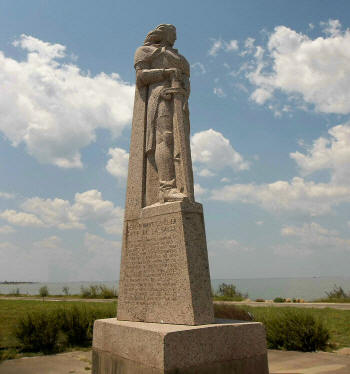 (June
12, 2012)
Enlarge
Indianola, Texas (June
12, 2012)
Enlarge
Indianola, Texas
Enlarged Views-Back Button to Return
(1844-1886) First called by German immigrants Karlshaven, an important
port of Texas. Cargoes of ships were hauled to and from points in Texas
and Mexico by carts until 1860 when the San Antonio and Mexico Gulf
Railroad and the Indianola Railroad were completed to Victoria. The town
was partly destroyed with great loss of life by a hurricane, September 17,
1875. It was rebuilt but completely destroyed by another hurricane, August
20, 1886.
Absolutely nothing remains from the time it was garrisoned by CS and US
forces, but it was a vital position for both sides. Notice nothing around
the monument and low land elevation.
The statue is of the famous French explorer LaSalle. Recently one of his
ships was found underwater and excavated by Texas A&M University. |
| |
|
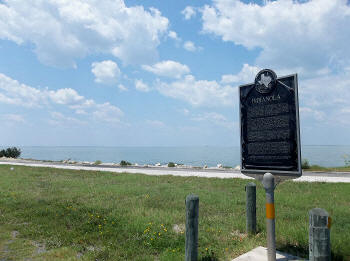 (June
12, 2012)
Enlarge
Detail Two Tales of One
City (June
12, 2012)
Enlarge
Detail Two Tales of One
City
A view of the Indianola Marker with (Port) LaVaca in the background to the
left.
This photo was taken on June 22, 2012 after reading the following
accounts, we decided to see the place.
Read More |
| |
|
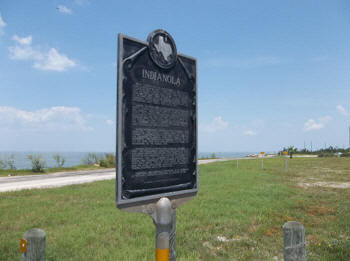 (June
12, 2012)
Enlarge View
toward Matagorda Island (June
12, 2012)
Enlarge View
toward Matagorda Island
This photo was taken looking toward Matagorda Island from the site of
Indianola, Calhoun County, Texas. Fort Esperanza has long disappeared but
was on the tip of Matagorda Island guarding Pass Cavallo. This was an
extremely important site for Federals because it kept blockade runners
bottled-up. Cattle, Sugar, Rice, etc are still major items in this region.
A six day battle took place for this fort. |
| |
|
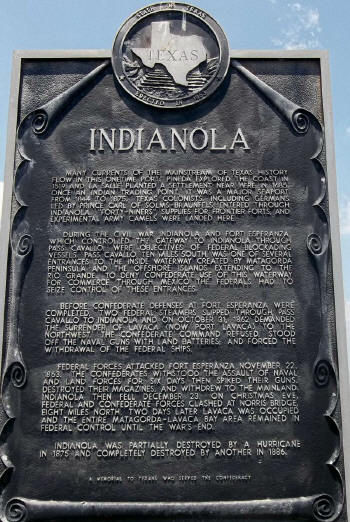 (June
12, 2012)
Enlarge
Indianola Texas Historical Marker (June
12, 2012)
Enlarge
Indianola Texas Historical Marker
Many currents of the mainstream of Texas history flow in this onetime
port. Pineda explored the coast in 1519 and La Salle planted a settlement
near here in 1685. Once an Indian trading point, it was a major seaport
from 1844 to 1875. Texas colonists, including Germans led by Prince Carl
of Solms-Braunfels, entered through Indianola. "Forty-niners", supplies
for frontier forts, and experimental Army camels were landed here landed
here."
During the Civil War Indianola and Fort Esperanza, which controlled the
gateway to Indianola through Pass Cavallo, were objectives of Federal
blockading vessels. Pass Cavallo, ten miles south, was one of several
entrances to the inside waterway created by Matagorda Peninsula and the
offshore islands extending to the Rio Grande. To deny Confederate use of
this waterway for commerce through Mexico the Federals had to seize
control of these entrances. Before Confederate defenses at Fort Esperanza
were completed, two Federal steamers slipped through Pass Cavallo to
Indianola and on October 31, 1862 demanded the surrender of Lavaca (now
Port Lavaca) to the northwest. The Confederate command refused, stood off
the naval guns with land batteries, and forced the withdrawal of the
Federal ships. Federal forces attacked Fort Esperanza November 22, 1863.
The Confederates withstood the assault of naval and land forces for six
days then spiked their guns, destroyed their magazines, and withdrew to
the mainland. Indianola then fell December 23. On Christmas Eve, Federal
and Confederate forces clashed at Norris Bridge, eight miles north. Two
days later Lavaca was occupied and the entire Matagorda-Lavaca Bay area
remained in Federal control until the war's end.
Indianola was partially destroyed by a hurricane in 1875 and completely
destroyed by another in 1886. A memorial to Texans who served the
Confederacy. (1963)
This marker was photographed in the afternoon on June 22, 2012. |
| |
|
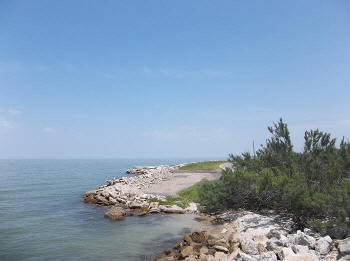 (June
12, 2012)
Enlarge
Indianola to Esperanza (June
12, 2012)
Enlarge
Indianola to Esperanza
This is a view taken June 22, 2012 from the site of Indianola looking
across the bay towards Matagorda Island.
The following is an excerpt from Reminiscences of the Boys in Gray
1861-1865, compiled by Miss Mamie Yeary page 607.
A.M. Phillips Co. "G", Likens' 35th Texas Cavalry "Our army was stationed
at the mouth of the Brazos River and as far up the coast as Powderhorn.
This is when the Federals were trying to invade Texas in 1864. (sic
1863-64). They withdrew and went up the Red River (Louisiana). We were
ordered on a forced march to meet them,..."
It should be noted that in the Official Records of the War of the
Rebellion, Major William Amos Wortham was in temporary command of Likens'
35th Texas Cavalry Regiment on March 19 at camp on the LaVaca when he
received the order to take the command in order to stop Union advances in
Louisiana. Ruben Brown's 35th Texas Cavalry Regiment, Duff's 33rd Texas
Cavalry Regiment, Hobby's 8th Texas Infantry Regiment, and others remained
along the Texas Gulf Coast. Many of the men in these regiments were
essentially defending their homes along the Texas coast so they had an
intimate knowledge of the landscape, thus providing a decided advantage
against Northern troops. Due to the fact that both Brown's and Likens'
regiments for the same numerical designation there has been much confusion
about the activities of both since they served simultaneously in roughly
the same area.
PS. The Spanish word Esperanza means "Hope/Wish" in English.
|
| |
|
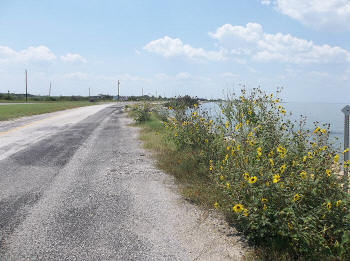 (June
12, 2012)
Enlarge Road
from Indianola to Port Lavaca (June
12, 2012)
Enlarge Road
from Indianola to Port Lavaca
This desolate road along the shoreline (now closed to traffic) illustrates
the low level of Indianola and the very flat land around it and Port
Lavaca. At the time of the war Indianola was an important port city, but
now it is gone. Also, at the time of the war, Port Lavaca was known as La
Vaca or Lavaca, which means "the cow" in Spanish. Port Lavaca is an
important port and city today. |





